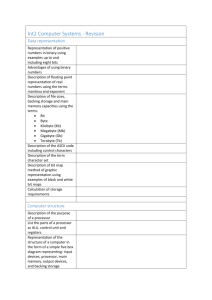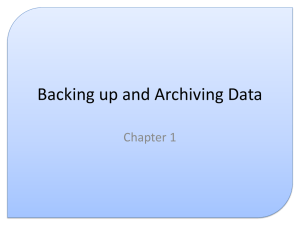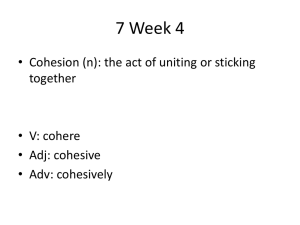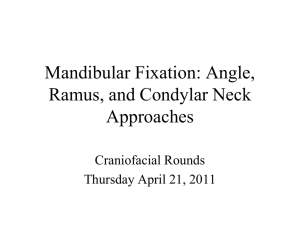Storage Devices and Media
advertisement
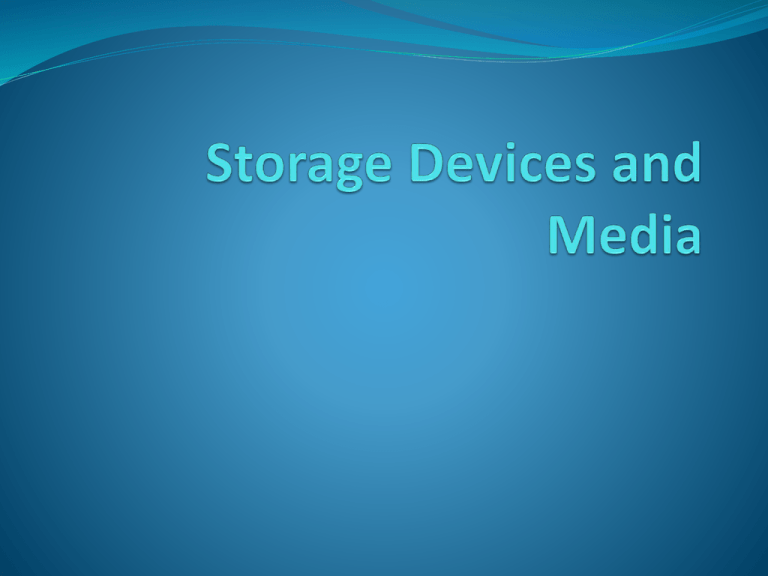
Syllabus Contents he syllabus says that you should be able to: describe common backing storage media and their associated devices: magnetic tapes, CDs (all types), DVDs (all types), DVD-RAM discs, HD DVD discs, Blu-Ray discs, hard discs, memory sticks, flash memory identify typical uses of the storage media, including types of access (e.g. serial/sequential, direct/random) and access speeds; describe the comparative advantages and disadvantages of using different backing storage media; define the term backup and describe the need for taking backups; describe the difference between main/internal memoryand backing storage, stating the relative benefits of each in terms of speed and permanence. Main Memory Main memory (sometimes known as internal memory or primary storage) is another name for RAM (and ROM). Main memory is usually used to store data temporarily. In the case of RAM, it is volatile (this means that when power is switched off all of the data in the memory disappears). Main memory is used to store data whilst it is being processed by the CPU. Data can be put into memory, and read back from it, very quickly. Backing Storage Backing storage (sometimes known as secondary storage) is the name for all other data storage devices in a computer: hard-drive, etc. Backing storage is usually non-volatile, so it is generally used to store data for a long time. Backing up data Backing up refers to copying files of stored data onto separate storage medium in case of a problem with the main storage medium. The backups are often stored in a different place to the current location. Reasons for backing up data Data could be lost due to the failure of the original device e.g a head crush, possible corruption of files Hackers could be responsible for corruption In case the files must be used while at the same time protecting the original files N.B Backing up data does not necessarily protect against viruses. Types of access Serial Access Direct access Serial Access In this system access to data starts at the beginning until the required information is found. It is used mainly on magnetic tape systems. Speed of access and order are not important. In magnetic tapes a new tape is required to update information.Old information is merged with the new data. Direct Access It is used with magnetic disks and optical media. The computer uses a program to calculate the position where data is stored and it is accessed directly. It is used in applications where access speed is vital like online and real-time process systems When updating data the new data is written to the next available location and the position recalculated. Types of Backing Storage Media Backing storage ensures that data is stored permanently and can be accessed later. It can be internal or external. Magnetic Optical Solid state Magnetic tapes Made of thin strips of plastic coated with a magnetic layer. It is fed through a read/write head. Data is stored as magnetised bits and accessed sequentially. Uses- Used when large storage capacities are required and speed is not critical e.g batch processing cheques, Utility bills, payrolls and backups. Advantages Cheaper than other storage media Robust- encased in a cartridge Data transfer rate is fast Can easily be kept away from the computer Disadvantages Access is slow Updating files requires a new tape Fixed hard disks Fixed inside the computer and has platters on which data is written. It stores important programs on the computer such as operating systems. They are used by an program that requires fast access to data e.g realtime systems in robotics,rocket lauching, online systems and on file servers Advantages and Disadvantages Advantages Data transfer rate is fast Data access times are fast Large storage capacity Disadvantages They are fragile Portable hard disks They are similar to fixed hard disks and can be connected and disconnected from a computer easily Uses-They are used as backup media or for transferring server software from one computer to another. Advantages and Disadvantages Similar to fixed hard disks but are slower when accessing data and more expensive Prep- Do notes on the remaining storage devices Optical Backing Storage Media They operate using a laser beam. It reads from and writes to the disk. The disk is polycarbonate plastic covered in reflective material. This is etched into using a laser beam. The ‘pits’ formed represent the data. CD ROMS/DVD ROMS The main difference is their storage capacity. DVDs use a shorter wave length of laser light than CDs. They are used for applications which require the prevention of the deletion of data. List examples of uses. Adv. And Disadv. Adv -DVDs hold more data than CDs -CDs are cheaper -Both are more robust than hard disks Disadv -Data transfer rates are slower for both CDs and DVDs -Data access times are longer CD Rs/DVD Rs A laser beam causes spots on the dye to be heated up and the reading process distinguishes between the heated and unheated spots. Used for home recordings of cds and dvds Adv -Cheaper -Cannot be accidentally written over Disadv -Can only be recorded once -Not all CD players can read CD Rs CD RWs/DVD RWs The recording surface is a metallic alloy layer. It can exist in anamorphous state or a crystalline state Adv -Can be used more than once -Different versions of files can be overwritten Disadv -They are expensive -Files can be overwritten accidentally DVD RAMs This is a newer technology. Data is stored in concentric tracks like magnetic media. They have quicker access times and an in built data check to ensure that data is written correctly. Used in camcorders, archiving and general data storage. Adv and Disadv Adv -They have a bigger storage capacity -More durable Disadv -Not compatible with most DVD players -Expensive Blu-ray disks They have the largest storage capacity: 25, 50 and 100 Gb. They use a shorter wave length laser beam using light that is close to the blue/violet spectra. Uses-games consoles, camcorders, entertainment Adv -Large storage capacity -Data transfer rates are high -Access speeds are high Disadv -Expensive -Problems with encryption techniques for preventing piracy Minidisks Uses magnetic and optical technologies for recording data. One site is heated and the other side is magnetised. It can be wrtten several times. The disk is permanently housed in a cartridge. Used in portable music players Adv -Can be recorded over many times -Robust Disadv -Transfer rates are slower -Hold less data -Expensive Solid State Backing Storage They are made of silicon chips consisting of rows and columns of cells. Each cell is made of two transistors separated by a thin oxide layer. They have no moving parts. The cell has a value of 1 or 0 depending on its charge. Memory Sticks or pen drives Connected to a computer via the usb port. Used for transporting files and software fixes. Adv -Compact, robust and do not need drivers to operate Disadv -Cannot be write protected -More expensive/Gbyte of storage

